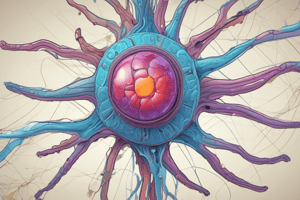Podcast
Questions and Answers
What is the main function of the cell membrane?
What is the main function of the cell membrane?
- To control the passage of materials into and out of the cell (correct)
- To synthesize proteins and lipids
- To provide structural support to the cell
- To store genetic information
What is the composition of the phospholipid bilayer in the cell membrane?
What is the composition of the phospholipid bilayer in the cell membrane?
- Two layers of phospholipids with a hydrophobic head and a hydrophilic tail
- One layer of cholesterol with a hydrophilic head and a hydrophobic tail
- Two layers of phospholipids with a polar hydrophilic head and a non-polar hydrophobic tail (correct)
- One layer of phospholipids with a hydrophilic head and a hydrophobic tail
What is the function of receptor-mediated endocytosis?
What is the function of receptor-mediated endocytosis?
- To control the passage of materials into and out of the cell
- To provide structural support to the cell
- To facilitate the uptake of specific molecules into the cell (correct)
- To synthesize proteins and lipids
What is the term for the outer surface of the cell membrane containing carbohydrates?
What is the term for the outer surface of the cell membrane containing carbohydrates?
What is the purpose of the trilaminar structure of the cell membrane?
What is the purpose of the trilaminar structure of the cell membrane?
What is the primary function of mitochondria in a cell?
What is the primary function of mitochondria in a cell?
What is the function of rough endoplasmic reticulum in protein-forming cells?
What is the function of rough endoplasmic reticulum in protein-forming cells?
What is the characteristic of smooth endoplasmic reticulum in terms of cell type?
What is the characteristic of smooth endoplasmic reticulum in terms of cell type?
What is the result of cells lacking hormone receptors in dwarfism?
What is the result of cells lacking hormone receptors in dwarfism?
What is the name of the process by which mitochondria replicate themselves?
What is the name of the process by which mitochondria replicate themselves?
Flashcards are hidden until you start studying
Study Notes
Cell Structure and Function
- The cell is the structural and functional unit of the body, composed of cytoplasm and a nucleus.
Cytoplasm
- Cytosol: the fluid component of cytoplasm
- Organelles:
- Membranous organelles: permanently present in all living cells, performing vital functions
- Non-membranous organelles: also present in cytoplasm
- Cytoskeleton: provides structural support and shape to the cell
- Inclusions: various substances present in the cytoplasm
Cell Membrane
- Surrounds the cell, sometimes too thin to be seen (6-9 nm) under light microscopy
- Special stain: silver (Ag), PAS
- Electron microscopy: trilaminar (trilamellar) structure, formed of three layers (two dark lines and a light line in-between)
- Molecular structure:
- Lipid: phospholipids arranged in a bilayer, with cholesterol within the hydrophobic layer
- Protein: intrinsic (integral) and extrinsic (peripheral) types
- Carbohydrates: form the cell coat (glycocalyx) on the outer surface, composed of glycolipid and glycoprotein
- Functions:
- Protection of the cell
- Selective permeability: controls passage of materials into and out of the cell
- Cell coat functions: adhesion, recognition, rejection, and receptor formation
Clinical Note
- Dwarfism: occurs when cells lack growth hormone receptors, leading to stunted growth
Mitochondria
- Power house of the cell, more abundant in active cells
- Light microscopy: acidophilic when large in number, special stain: iron hematoxylin or Janus green
- Electron microscopy: rounded or oval, with outer smooth membrane and inner membrane folded into cristae
- Functions:
- Synthesis of energy (oxidative phosphorylation)
- Storing of energy in the form of ATP
- Release of energy by transforming ATP into ADP
- Capable of self-replication (by binary fission) due to its own DNA
Endoplasmic Reticulum
- Endo=inside, plasma=cytoplasm, reticulum=network
- Two types: rough endoplasmic reticulum (rER) and smooth endoplasmic reticulum (sER)
- Rough endoplasmic reticulum (rER):
- Abundant in protein-forming cells
- Light microscopy: basophilic (ribosomes)
- Electron microscopy: membranous interconnected tubules (cisternae) with ribosomes attached to the surface
- Functions:
- Synthesis and segregation of protein
- Initial glycosylation of glycoproteins
- Formation of transfer vesicle to be transported to Golgi apparatus for secretion
- Share in the formation of lysosomes
- Smooth endoplasmic reticulum (sER):
- Abundant in steroid-forming cells
Studying That Suits You
Use AI to generate personalized quizzes and flashcards to suit your learning preferences.




